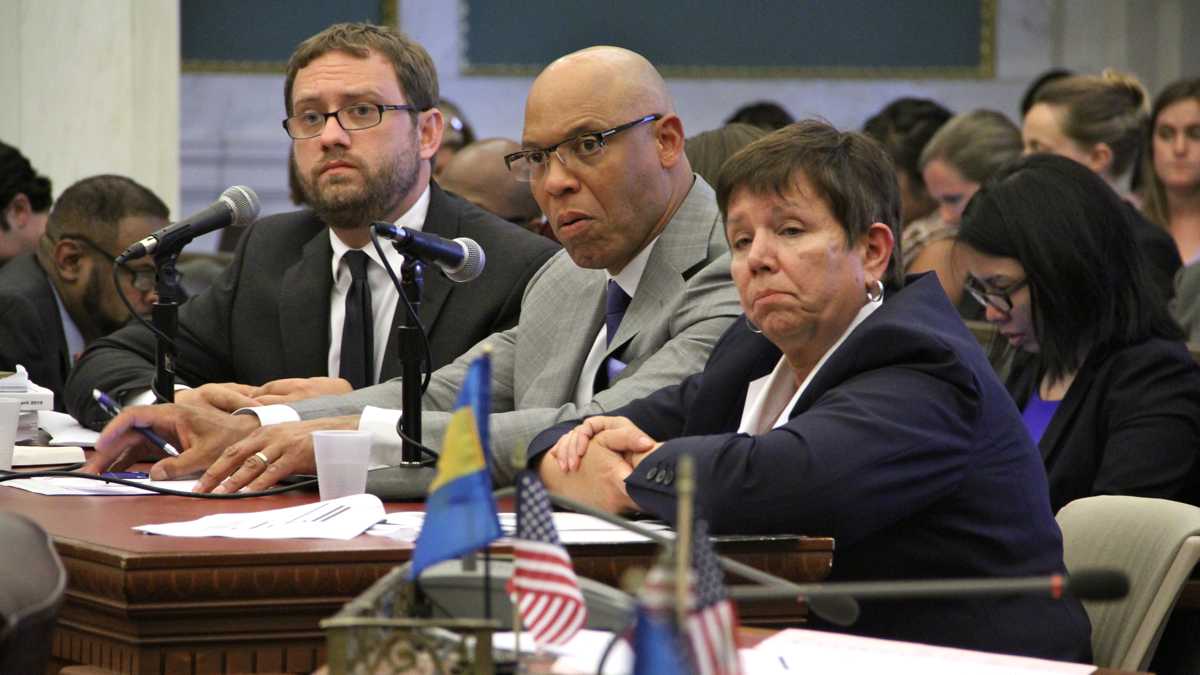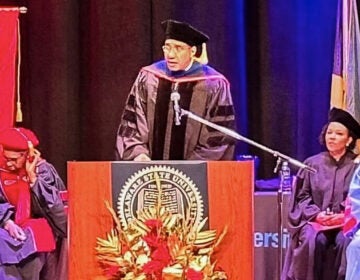Philly schools see big shakeup at the top, but principal turnover recedes
Listen
Among the high ranking administrators to leave the Philadelphia School District is Chief Financial Officer Matthew Stanski, left, shown here at a City Hall budget hearing with Superintendent William Hite and SRC Chair Marjorie Neff. (NewsWorks file photo)
Winds of change have been blowing through the Philadelphia School District.
Several top administrators have announced their departures in the past few months.
In May, Chief Financial Officer Matt Stanski said he was leaving to take a similar post in the Montgomery County, Maryland, school district.
In July, Deputy Superintendent Paul Kihn resigned.
A few weeks later, Chief Academic Officer Donyall Dickey accepted a position as chief schools officer in Atlanta.
In late July, Grace Cannon, the head of the newly created Office of New School Models, stepped down.
Cannon had to take on additional responsibility during the 2014-15 school year after Saliyah Cruz left her position as founding principal of an innovative new high school less than two weeks into the year.
Despite the shakeup, Superintendent William Hite said the turnover will have little impact on operations.
“It does not change the work. The work continues,” he said.
Stanski and Kihn joined the Philadelphia School District in 2012, the same year Hite was hired. Dickey served as an assistant superintendent in 2013-14, before being bumped to chiegf academic officer last year.
Cannon came to the district in 2011.
“Three years is a long time for a senior level administrator,” said Hite. “The work is hard, and it’s even harder in districts that have had to make some of the decisions we’ve had to make here in Philadelphia against many of the revenue challenges that we’ve had.”
This poses a Catch-22 for a school district such as Philadelphia. The very difficulty that pushes people away is the reason why stability and long term accountability are needed.
But Hite said retaining senior administrators can be challenging when other districts are actively recruiting them and offering larger paychecks.
“When you have great team members, everybody in the country is after them, and a lot of the individuals who have left, have left for a higher salary,” said Hite.
On paper, those better-paying jobs are easier. In Philadelphia, the chief financial officer has about 20 staffers; in Montgomery County, Maryland, Matt Stanski will have 100, said Hite.
Hite said he actively ignores opportunities presented by other districts and recruiters.
Networking
The position of deputy superintendent has been discontinued as Hite implements a new plan for dividing and overseeing schools.
The district’s “learning networks” have expanded from eight to 13. Nine of them will be geographically based, and most will now have fewer schools, giving assistant superintendents a chance to develop more intimate relationships with their assignments.
Four new networks have been created.
An “innovation” network groups seven of the district’s “research and development” schools, where educators are encouraged to embrace new pedagogical models. This network will be headed by Science Leadership Academy Principal Chris Lehmann, who will also cover for Cannon’s departure.
An “autonomy” network groups the district’s specialty and citywide admission schools with a school progress report score greater than 40.
A “turnaround” network groups the 12 remaining “Promise Academy” schools.
An “opportunity” network groups the district’s 24 alternative schools.
Principals
On a school-by-school level, there will be fewer leadership changes in 2015-16.
Twenty-nine schools will have a new principal this year, down almost 40 percent compared with last year, when 47 schools saw new leaders.
In 2013-14, 58 schools had a turnover at the top.
This year, of the 29 principals new to a school, seven are new to the district, and 16 are first-time principals.
Of those sixteen, the majority are district graduates.
Also of note:
The number of principal retirements dropped by almost 60 percent from 2014 to 2015 – from 55 to 23.
And the number of principal resignations dropped by almost 40 percent from 2014 to 2015 – from 22 to 13.
WHYY is your source for fact-based, in-depth journalism and information. As a nonprofit organization, we rely on financial support from readers like you. Please give today.





